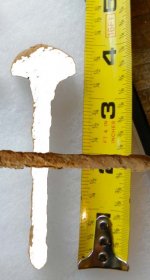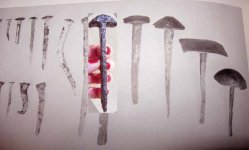M
Navigation
Install the app
How to install the app on iOS
Follow along with the video below to see how to install our site as a web app on your home screen.
Note: This feature may not be available in some browsers.
More options
You are using an out of date browser. It may not display this or other websites correctly.
You should upgrade or use an alternative browser.
You should upgrade or use an alternative browser.
TheCannonballGuy
Gold Member
- Feb 24, 2006
- 6,593
- 13,357
- Detector(s) used
- White's 6000, Nautilus DMC-1, Minelab
- Primary Interest:
- Relic Hunting
Re: A Big Nail?? or Boreman Fuse Punch
Your guess that it might be a Bormann fuze-punch is understandable, due to the very general resemblance ...but it is definitely not that. Rather than bore (almost) everybody by listing all the reasons, I'll focus on just one. A Bormann fuze-punch's blade-tip is pointier and much smaller than we see on your object, because the fuze-punch was intended to make only a 3/16th-inch hole in the fuze.

Your guess that it might be a Bormann fuze-punch is understandable, due to the very general resemblance ...but it is definitely not that. Rather than bore (almost) everybody by listing all the reasons, I'll focus on just one. A Bormann fuze-punch's blade-tip is pointier and much smaller than we see on your object, because the fuze-punch was intended to make only a 3/16th-inch hole in the fuze.
Upvote
0
Daedalus
Hero Member
- Feb 2, 2011
- 951
- 18
- Detector(s) used
- Minelab Sovereign GT / MineLab X-Terra 705
- Primary Interest:
- All Treasure Hunting
Re: A Big Nail?? or Boreman Fuse Punch
This look like an Wood wedge from what I see , but that is just a guess and just because it looks like a wedge does not mean that is what it is .
But it may give you a place to start looking .

This look like an Wood wedge from what I see , but that is just a guess and just because it looks like a wedge does not mean that is what it is .
But it may give you a place to start looking .
Upvote
0
OP
OP
MiniMe
Guest
- Thread starter
- #5
Re: A Big Nail?? or Boreman Fuse Punch
Thanks for the info on the fuse punch CannonballGuy - That wasn't boring at all. Thanks for looking.

TheCannonballGuy said:Your guess that it might be a Bormann fuze-punch is understandable, due to the very general resemblance ...but it is definitely not that. Rather than bore (almost) everybody by listing all the reasons, I'll focus on just one. A Bormann fuze-punch's blade-tip is pointier and much smaller than we see on your object, because the fuze-punch was intended to make only a 3/16th-inch hole in the fuze.
Thanks for the info on the fuse punch CannonballGuy - That wasn't boring at all. Thanks for looking.
Upvote
0
With the length of the actual "spike" portion being only about 3 1/2 inches, and the thickness being only about 1/4 of an inch, I believe that it is too small to be a railroad spike or a wedge. Additionally that style head and spike date back to the 1760-1780 time frame, and were handwrought. The head was designed for extreme holding power, wherever it may have been needed. It the early-mid years of the 19th century, this style fastener was also used on Conestoga wagons (and others) to anchor the canopy to the frame. Later, while the head design remained the same, the wedge-type shank was replaced with threads and a curled wing-nut. I may well be wrong, but that is what my guess would be.
Attachments
Upvote
0
Great I.D.!!!!
I agree, it is a hand wrought nail.
I've read a little about nails in colonial history, and it is quite interesting. In the early colonial years, especially after Independence, and during the Embargo, nails were quite scarce.
Of course, blacksmiths were still making nails long after machine made nails were common and cheap, even into the 1900's. I'm told that Colonial Williamsburg still makes hand wrought nails today, for use in their building projects.
I've met a few woodworking traditionalists that seek out hand wrought nails, as well has square cut machine made nails. FWIW, square cut nails of any type are supposed to be far less likely to split the wood they are being driven into.
Very cool find!!!!!
I agree, it is a hand wrought nail.
I've read a little about nails in colonial history, and it is quite interesting. In the early colonial years, especially after Independence, and during the Embargo, nails were quite scarce.
Of course, blacksmiths were still making nails long after machine made nails were common and cheap, even into the 1900's. I'm told that Colonial Williamsburg still makes hand wrought nails today, for use in their building projects.
I've met a few woodworking traditionalists that seek out hand wrought nails, as well has square cut machine made nails. FWIW, square cut nails of any type are supposed to be far less likely to split the wood they are being driven into.
Very cool find!!!!!
Upvote
0
Bigcypresshunter
Gold Member
- Dec 15, 2004
- 27,000
- 3,339
- Detector(s) used
- 70's Whites TM Amphibian, HH Pulse, Ace 250
- Primary Interest:
- Beach & Shallow Water Hunting
My Dad was a carpenter. He used to flatten the point on a nail to keep the wood from spitting.clovis97 said:FWIW, square cut nails of any type are supposed to be far less likely to split the wood they are being driven into.
Upvote
0
Top Member Reactions
-
 3496
3496 -
 1980
1980 -
 1887
1887 -
 1200
1200 -
 1121
1121 -
 1021
1021 -
 875
875 -
 826
826 -
 823
823 -
 794
794 -
 743
743 -
 664
664 -
 576
576 -
 567
567 -
 502
502 -
 449
449 -
 433
433 -
E
413
-
 404
404 -
 392
392
Users who are viewing this thread
Total: 2 (members: 0, guests: 2)










